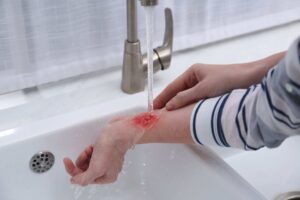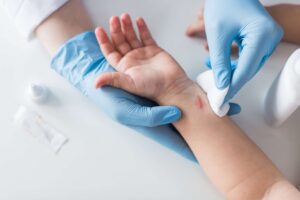 Wounds and injuries are an everyday occurrence. With proper care and treatment, most of them go away in no time. But what happens if bacteria gain access to the site of injury? Wound infections are common and minor ones can generally be treated at home. On the contrary, persistent or severe infections warrant medical attention.
Wounds and injuries are an everyday occurrence. With proper care and treatment, most of them go away in no time. But what happens if bacteria gain access to the site of injury? Wound infections are common and minor ones can generally be treated at home. On the contrary, persistent or severe infections warrant medical attention.
If left untreated, infections may spread from their site of origin; potentially resulting in cellulitis if it reaches the deep tissues underlying the wound, or osteomyelitis if it spreads to the bone. These diseases manifest as swelling, redness, and pain in the area and can affect quality of life if not checked in time.
What you want to avoid is having the infection spread through your bloodstream. This extreme immune reaction, known as sepsis, can be life-threatening, and cause multiple organ failures if the infection reaches them. Therefore, proper wound care and management must be a top priority so that it doesn’t develop an infection.
How Do I Know if a Wound is Infected?
Most wounds heal within a couple of weeks, but if your wound starts to get worse rather than better, that is the hallmark sign of wound infection. There is usually a contributing factor playing a part in why your wound isn’t healing such as poor blood circulation, malnutrition, or an infection.
As the wound worsens, the injury becomes more painful and starts looking red around the edges – the redness being wider than the person’s thumb. Other signs of an infected wound may include:
- A change in color or size of the wound
- Swelling
- A foul odor
- The skin feeling warm or hot
- Releasing a green or yellow discharge (pus)
- Weakness in the wound area
- Red streaks on the skin surrounding the wound
- Tenderness
- Blisters, brown, or black tissue
If the infection spreads beyond the wound, you may experience systemic symptoms such as fever (high temperature) and chills, nausea, vomiting, pains, and aches.
How Does A Wound Get Infected?
As discussed above, an infection arises when pathogens such as bacteria enter the skin of your wound and colonize. This includes bacteria such as Staphylococcus aureus, Escherichia coli, and Streptococcus among others.
Any of these may come from your skin as there are thousands of germs on you at all times or from the external environment such as soil or water. The cause of injury may result in an infection as well. For example, if the object that caused the wound was dirty or rusty, the chances of transmission are high. Similarly, a human or animal mouth is riddled with bacteria, which is why wounds from bite injuries are prone to infection.
If your wound is deep, large, has jagged edges, or resulted from a puncture (through a nail or glass), it needs special care to prevent infection. Moreover, wounds in your limbs or groin are also more susceptible to pathogen growth.
To sum up, bacteria can come from anywhere – even in the most sterile environments such as an operating room as surgical infections are also a common occurrence. Even with proper care, many comorbidities can make you more vulnerable to infectious growth. This includes:
- Type 1 or 2 diabetes
- Immunosuppression due to an immune system disease such as AIDS or medication such as chemotherapy or steroids
- Obesity
- Poor mobility, such as in bedridden individuals
- Smoking
- Old Age
- Poor Hygiene
- Nutrient and vitamin deficiencies
While old age slows skin healing and poor hygiene is self-explanatory, other factors are mostly associated with poor blood circulation. If the wound doesn’t receive adequate oxygen and nutrients, recovery is slow and the chances of infection are high.
How To Prevent a Wound Infection?
 Wounds are common but what you do while caring for that wound determines if an infection develops. Before anything else, it is important for you to thoroughly wash your hands with warm water and soap before you touch the wound. Similarly, anything that contacts the injury must be carefully sterilized such as rubbing alcohol on tweezers before using them.
Wounds are common but what you do while caring for that wound determines if an infection develops. Before anything else, it is important for you to thoroughly wash your hands with warm water and soap before you touch the wound. Similarly, anything that contacts the injury must be carefully sterilized such as rubbing alcohol on tweezers before using them.
A clean gauze or bandage can be used to apply pressure and stop any bleeding. If the edges are not holding together, you may need to get stitches. Either way, start by cleaning the wound and the skin around it by running it under warm, boiled water. You may also use soapy water for the skin around the site and if none of this is possible, alcohol wipes work as well.
If there is any debris like dirt, grass, hair, or gravel, gently remove that with tweezers. You may also apply petroleum jelly or antibiotic cream to keep the bacteria out. However, do not use hydrogen peroxide or iodine to prevent skin irritation.
The next step is to let the skin air-dry, before covering it with a suitable dressing at all times. This can be a bandage or plaster, but avoid using something that may stick to the wound, and try to change this dressing at least once daily. Avoid making it damp or dirty, and keep an eye out for any signs of infection.
To prevent wound infection, keep it secure from external factors such as urine, stool, body drainage, animal hair or feces, or even scabs from your fingernails. All of these factors slow healing and raise infection risk.
Treating A Wound Infection
 Instead of self-medicating a wound infection, the best course of action is to visit a wound care specialist or primary care physician. A professional can assess the issue and provide you with appropriate treatment to promote healing and recovery. If you spot any of the following signs it’s crucial to seek medical attention:
Instead of self-medicating a wound infection, the best course of action is to visit a wound care specialist or primary care physician. A professional can assess the issue and provide you with appropriate treatment to promote healing and recovery. If you spot any of the following signs it’s crucial to seek medical attention:
- An inability to clean the wound of debris such as gravel or grass
- A bite or a dirty object is the cause of the wound
- Infection symptoms such as pain and redness, discharge, and fever
- Multiple weeks without the wound healing
- An inability of the wound’s edges to stay together
- Any large or deep wound
The recommended treatment plan will vary from injury to injury, depending on cause and severity. However, most treatment plans typically involve a process called wound debridement. This is the removal of any dirty or dead tissue to promote healing and prevent spread. The specialist may also flush the wound with an antibiotic solution and apply an ointment. If the wound has pus (dead inflammatory cells), the site may be opened to drain the fluid as well.
Since bacteria are the cause of most wound infections, oral or IV antibiotics are the primary way to go. Your doctor will prescribe something and you must complete the course of treatment to prevent antibiotic resistance. This, coupled with wound care prescribed by your doctor, is usually enough to solve the issue.
If the wound is deep or large, stitches may be required to close it. Similarly, if the cause of injury was something rusty or dirty or an animal bite, you may need a tetanus injection as well. Tetanus is a life-threatening condition in which bacteria release harmful toxins inside your body that damages the central nervous system.
The Bottom Line
Everyone gets wounds from time to time but wound infections are something you want to avoid at all costs, as they not only delay healing but may also transform into something life-threatening. Infection can be prevented through efficient wound care and management by running your wound under clean water, removing any debris, applying antibiotic ointment, and covering it with a dressing that needs regular changing.
If it still develops into an infection identifiable by redness, swelling, and worsening of other symptoms, it’s imperative to contact a wound care center as soon as possible. If identified early, wound infection is nothing but a minor blip in your long life.
Let West Coast Wound Center Help You Heal
If you or someone you care for has suffered a serious wound that might be infected, the specialized staff at West Coast Wound Center is here to help. We healed wounds 30% faster than the national average and help improve our patient’s quality of life through our full spectrum of wound care services. Make an appointment at our Fresno center and find out how we can get you on the path to healing and recovery.
